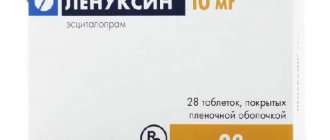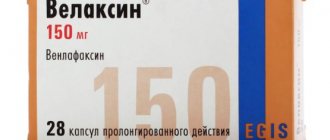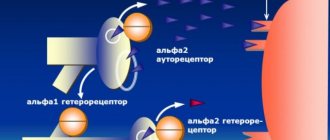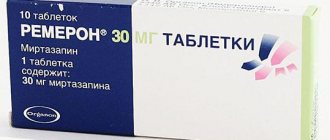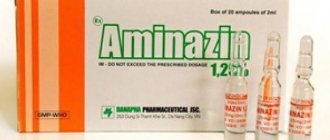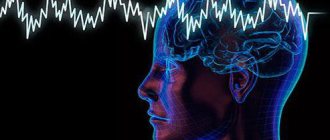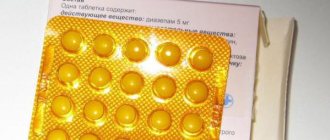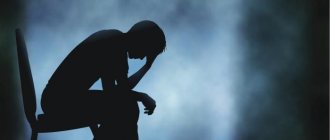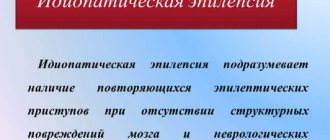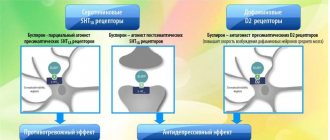Antidepressant: Elicea Manufacturer: KRKA-RUS LLC (Russia) Active ingredient: Escitalopram
Sometimes there are moments in life when you cannot do without mood-improving medications. Doctors call them antidepressants. This drug, Elicea, is very effective for panic attacks, depression, and anxiety. It doesn’t matter at what stage of development the disease is, or what type. This medicine differs from most medications in its composition. There are no toxic side effects. Psychologists prescribe it for the treatment of various fears. For example, if a person has a phobia of closed spaces. Or in mild stages of alcoholism.
Presented in the form of white tablets. Has no smell. The shell is film. The main substance is escitalopram oscalate. Lactose, starch, magnesium stearate, crospovidone auxiliary elements.
Pharmacological profile
Elicea is a selective serotonin reuptake inhibitor.
The active substance has an effect on the Formula of escitalopram
neurotransmitters serotonin, adrenaline and dopamine.
The production of more serotonin improves the patient’s mood, reduces apathy and lethargy, as well as improves appetite and corrects sleep phases.
Escitalopram blocks the natural breakdown of serotonin, as well as its reuptake. During a depressive episode, the patient develops a lack of dopamine and serotonin in the synaptic cleft. Elycea increases their concentration, which leads to an improvement in the patient's condition.
Absorption of the substance is almost complete, independent of the food consumed. Reaches its peak content in the blood 4 hours after consumption. Bioavailability of the drug is within 80%. The drug is eliminated 30 hours after taking the next tablet.
Interaction
The active substance, escitalopram, in combination with the following drugs may be accompanied by undesirable symptoms:
- With drugs that lower the seizure threshold, with tricyclic antidepressants , antipsychotics - derivatives of phenothiazine , thioxanthene , butyrofenone , as well as with Mefloquine , Bupropion and Tramadol - the likelihood of developing seizures increases.
- With Lithium , tryptophan - enhancing their pharmacological action.
- With indirect anticoagulants and drugs that have an effect on platelet aggregation (including atypical neuroleptics and typical antipsychotics, NSAIDs , acetylsalicylic acid , Ticlopidine and Dipyridamole ) - the risk of bleeding increases, which requires monitoring of blood clotting parameters at the beginning and upon termination therapy.
- With Metoprolol and Desipramine their concentrations double.
Scope of application and contraindications
The medicine is effective for depression, anxiety in the complex treatment of various mental disorders. The remedy is used to get rid of obsessive states and phobias. Elycea has a positive effect on patients suffering from panic and anxiety episodes.
An antidepressant is prescribed in the case of:
- long-term depressive episodes;
- panic attacks;
- social phobia;
- obsessive-compulsive disorder;
- anxiety states.
Like any other psychotropic drug, Elicea should be taken with extreme caution. It is imperative to consult a doctor, telling him about chronic diseases and substances used.
Contraindications:
- age less than 18 years;
- pregnancy and breastfeeding;
- lactase deficiency;
- glucose-galactose malabsorption syndrome;
- allergy to the active substance.
In addition, it is not advisable to take pills if you have epilepsy, cirrhosis and diabetes.
Mixing the drug with alcohol and other psychotropic drugs is strictly prohibited.
Elycea
Elicea® is not used during pregnancy (safety has not been established).
Due to the fact that escitalopram is secreted into breast milk, the use of the drug during breastfeeding is not recommended. If it is necessary to use Elicea® during lactation, breastfeeding should be discontinued.
Use for liver dysfunction
For liver dysfunction, the initial dose is 5 mg/day for 2 weeks. Depending on the patient's individual response, the dose may be increased to 10 mg/day. In severe liver dysfunction, slower dose titration is recommended.
Use for renal impairment
For mild or moderate renal failure (creatinine clearance more than 30 ml/min), no dose adjustment is required. In severe renal failure (creatinine clearance less than 30 ml/min), the drug should be prescribed with caution.
Use in children
The use of the drug in children under 18 years of age is contraindicated.
Use in elderly patients
The drug should be used with caution in elderly patients.
Course of treatment and recommended dosages
Tablets are taken orally once a day. The order of meals does not matter. For the treatment of depression, the dose is 10 mg per day.
If the duration of depressive episodes increases or if the patient's individual response is insufficient, the dosage is increased to 20 mg per day. Improvement occurs after 2-4 weeks from the start of therapy. When depressive conditions are alleviated, treatment must be continued for at least 6 months to avoid relapse.
Patients with phobias and panic attacks
For the treatment of phobias, as well as obsessive disorders, patients are prescribed 5 mg of the substance per day. After the first week of treatment, the dosage is increased to 20 mg. The peak effectiveness of treatment occurs after 3 months from the start of the course.
People suffering from panic attacks may experience worsening symptoms in the first weeks of treatment. This goes away after the 2nd week of the course. To avoid such situations, low initial doses are recommended for patients with such disorders.
During pregnancy and breastfeeding
It is not recommended to take antidepressants during pregnancy. This can have a negative impact on the development of the internal organs of the fetus. The drug is absorbed through the placenta and can harm the health of the unborn child.
During the course of treatment, it is advisable to stop breastfeeding. Escitalopram passes into breast milk and may affect the baby's central nervous system.
Prescription for children
Prescribing an antidepressant to minors is not recommended. Due to unstable hormonal levels in adolescents, severe deterioration of the condition is possible in the first weeks of therapy.
Taking Elicea at an early age can provoke aggression and antisocial behavior in adolescents. If it is not possible to avoid prescribing the medication, a course of therapy should be carried out under the strict supervision of a specialist.
Prescription for elderly people
Patients over 60 years of age require adjustment of the daily dosage. This is due to poor tolerability and a high risk of side effects at this age.
The course of treatment for such patients begins with a minimum dose of 5 mg. If side effects do not appear in the first week, the dosage can be increased to 10 mg.
Patients with diabetes
In case of diabetes mellitus, adjustment of administered insulin doses is necessary. Minors and other groups of patients at increased risk of suicide should receive treatment under close supervision.
In case of kidney and liver dysfunction
For people with mild kidney impairment, there is no need to adjust daily dosages. Patients with liver impairment should not exceed the dose threshold of 10 mg.
Antidepressant
There are situations during which it is impossible to do without antidepressants. One of them is the drug “Elycea”. The article will discuss useful information about the product and its analogues (Cipralex, Selectra): instructions for use, price, reviews.
Basic information about the drug "Elycea"
As mentioned above, the medication belongs to the group of antidepressants. It comes in the form of tablets, which can be round or oval.
The main active ingredient of the drug is escitalopram. As auxiliary components, it contains lactose monohydrate, crospovidone, povidone K30, pregelatinized starch, magnesium stearate, microcrystalline cellulose.
The product must be stored at a temperature of no more than 30 degrees. Its shelf life is 2 years.
In pharmacies "Elitsey", the price of which is about 1,400 rubles, is available with a prescription.
Indications for use
In what cases can “Elycea” be prescribed? The indications described in the instructions indicate that the product is used for:
- depression;
- panic disorders (including those accompanied by agoraphobia).
Only a doctor can prescribe the use of the drug!
Contraindications for use
There are situations during which treatment with the antidepressant “Elycea” is prohibited. Instructions for use indicate the impossibility of taking the drug if the patient has:
- hypersensitivity to the components of the drug;
- carbohydrate metabolism disorders;
- lactase deficiency, galactosemia, glucose-galactose malabsorption syndrome.
In addition, the drug cannot be used in combination with medications containing pimozide, as well as during therapy with MAO inhibitors.
The antidepressant "Elycea" is strictly prohibited for use during pregnancy, lactation, and also in childhood.
special instructions
Treatment with this drug should be carried out with extreme caution if the patient has:
- diabetes mellitus;
- uncontrolled epilepsy;
- chronic renal failure;
- liver cirrhosis;
- cardiac dysfunction;
- depression with suicide attempts;
- bleeding tendency;
- history of hypomania and mania.
Another important point: “Elycea” and alcohol are incompatible! Therefore, you should refrain from using it, as well as from treatment with alcohol-containing drugs.
In addition, it is recommended to avoid performing work that requires a high concentration of attention and driving vehicles, since “Elycea” (reviews from users are proof of this) can cause dizziness, confusion, hallucinations and other side effects, which we will talk about later .
Next, it’s worth talking about how to take the drug “Elycea” correctly and in what dosages. The instructions for use highlight several possible options.
For depressive episodes, the initial dose is 10 mg per day, but if necessary, it can be increased to 20 mg. The effect is usually achieved within 2 to 4 weeks from the start of therapy.
After the final disappearance of the symptoms of the disease, it is recommended to continue therapy for at least another six months to consolidate the achieved result. Treatment with the drug should be stopped for about 1-2 weeks, gradually reducing the dose.
This is necessary in order to avoid the possible occurrence of withdrawal syndrome.
When treating panic disorders, the initial dose is 5 mg per day, and from the second week of treatment increases to 10-20 mg. As a rule, the maximum effect can be achieved after three months of treatment.
For patients over 65 years of age, the maximum permitted daily dose is 5 mg.
For kidney disease, no dosage adjustment is required.
For liver diseases, treatment begins with 5 mg, and after 2 weeks the dose can increase to 10 mg per day.
Overdose
Use of the drug in doses that exceed the recommended may cause convulsions, drowsiness, dizziness, tremor, agitation, depression of consciousness, decreased blood pressure, arrhythmia, hypokalemia, respiratory depression, metabolic acidosis, nausea, vomiting.
In this case, gastric lavage, monitoring of cardiovascular function and other symptomatic therapy are performed.
Side effects
Almost any drug can provoke the appearance of any negative reactions in the body. Elicea tablets were no exception. Side effects from taking the drug may be as follows:
- Nervous system: dizziness, tremor, drowsiness or insomnia, restlessness, anxiety, paresthesia, nightmares. Less commonly, fainting, sleep disturbances, psychomotor agitation, panic disorders, taste disturbances, confusion, teeth grinding, suicidal thoughts and behavior, manic and convulsive disorders, aggressiveness, hallucinations, depersonalization, serotonin syndrome may be observed.
- Digestive system: decreased or increased appetite, diarrhea or constipation, nausea, vomiting. In rare cases, gastrointestinal (including rectal) bleeding and hepatitis may occur.
- Hematopoietic and cardiovascular systems: tachycardia, bradycardia, orthostatic hypotension, thrombocytopenia.
- From the respiratory system: sinusitis, yawning, nosebleeds.
- Genitourinary system: anorgasmia (in women), impotence, decreased libido, ejaculation disorders. Menorrhagia, metrorrhagia, priapism, and urinary retention are much less common.
- From the senses: tinnitus, visual disturbances, mydriasis.
- Endocrine system: in rare cases, inadequate production of antidiuretic hormone is possible.
- Musculoskeletal system: myalgia, arthralgia.
- From the skin: alopecia, excessive sweating, and in very rare cases - ecchymosis.
- Allergic reactions in the form of rash, itching, urticaria. In some cases, anaphylactic shock or Quincke's edema may occur.
- General: the appearance of weakness, swelling, increased body temperature.
As for laboratory indicators, “Elycea” (tablets) can provoke an increase in body weight, and in more rare cases, a decrease in weight.
If treatment with the drug is abruptly stopped, withdrawal syndrome may occur.
As you can see, the antidepressant "Elycea", the price of which is quite high, has a number of side effects. Moreover, some occur quite often.
Reviews about the drug
What do patients say about the antidepressant "Elycea"? Reviews from users talk about both the advantages and disadvantages of the drug. Let's look at each group separately.
It’s worth starting with the advantages that Elicea tablets have. Reviews from users indicate that the drug has a rapid effect, as a result of which the positive effect of therapy occurs in a short time. In addition, the drug is easy to use and relatively low cost compared to other antidepressants.
But there are also some disadvantages. The drug "Elycea" (reviews of those taking it repeatedly confirm this) has a number of side effects, which become even more noticeable if the dose is incorrectly selected.
Most often they manifest themselves in the form of a rash and severe itching. In addition, in some cases the remedy did not show any result at all, and it was necessary to look for another medicine.
Some patients complain of increased appetite after discontinuation of the drug, which contributed to rapid weight gain.
Analogues of the drug
As you know, almost all pharmaceuticals can be replaced with some other medicine. “Elycea” was no exception. Analogs of the drug have a similar type of action, but differ from it in their composition and some other characteristics.
Let's look at the two most well-known products: Selectra and Cipralex. Instructions for use, price, reviews and side effects - these are the issues that will be given special attention. For greater convenience, each of the drugs will be discussed in a separate section.
Just like Elicea, Selectra belongs to the group of antidepressants. The drug is available in the form of white oval tablets.
The main active ingredient of the drug is escitalopram. As auxiliary components, Selectra contains microcrystalline cellulose, magnesium stearate, croscarmellose sodium, silicon dioxide and talc.
The drug is used to treat depression of varying severity, as well as during panic disorders, including those accompanied by a fear of open space.
The use of Selectra is contraindicated during pregnancy and lactation, under the age of 15 years, in the presence of hypersensitivity to the components of the tablets. In addition, the drug is not used in combination with MAO inhibitors.
The antidepressant is used with extreme caution if the patient has diabetes, kidney, heart and liver diseases, as well as a tendency to bleeding.
The required daily amount of the drug depends on the type and nature of the disease. As a rule, the initial dose is 10 mg, but if necessary it can be increased to 20 mg.
Exceeding the dose of an antidepressant provokes drowsiness, clouding of consciousness, motor agitation, convulsions, tachycardia, arrhythmia, renal failure, and hypokalemia.
The development of side effects after using Selectra is usually observed within the first two weeks after the start of therapy. They may manifest themselves in the form of weakness, dizziness, movement disorders, convulsions, tremors, fever, drowsiness or insomnia.
Less commonly, taking this antidepressant can cause panic attacks, hallucinations, confusion, increased irritability, manic disorders, taste disturbances, diarrhea or constipation, itching and skin rashes, decreased appetite and libido.
Abruptly stopping the use of the drug may cause withdrawal syndrome, which is characterized by nausea, headaches, and dizziness.
The cost of the product is within 1000 rubles. Reviews about it are most often positive, although in some cases patients complain of some side effects: irritability, insomnia and loss of appetite. But in the end, they too are satisfied with the results achieved.
"Cipralex": instructions for use, price, reviews
Cipralex tablets also contain escitalopram as the active substance. The auxiliary components include magnesium stearate, croscarmellose sodium, anhydrous colloidal silicon, MCC and talc.
As for the indications for use, the required dose, contraindications, side effects and special instructions - they are completely similar to those of the main drug (Elycea). Therefore, we will not repeat ourselves.
The main difference is the cost of medications. The price for Cipralex is within 1,000 rubles per pack of 14 tablets, and 1,800 rubles for 28 pills.
As for the reviews about the drug, they are mostly positive. Patients note the high effectiveness of Cipralex and the very rapid onset of its effect on the body. That is why it is considered one of the best antidepressants.
Conclusion
As you can see, depression and other panic disorders can be dealt with with the help of special medications. Despite the fact that you can buy them in some pharmacies without a prescription, you should still consult your doctor before using such products.
Source: https://FB.ru/article/258882/antidepressant-elitseya-otzyivyi-prinimayuschih-instruktsiya-po-primeneniyu-pobochnyie-effektyi-analogi
Adverse reactions
Side effects when taking the antidepressant Elitsey are most reflected in the functioning of the nervous system, as well as the respiratory and digestive systems.
Possible malfunction of the central nervous system and cardiovascular system:
- tachycardia;
- hypotension;
- sleep disorders;
- tremor;
- anxiety;
- confusion;
- serotonin syndrome;
- dyskinesia;
- fainting;
- hallucinations;
- psychomotor agitation.
Side effects from the digestive tract:
- nausea after taking;
- loss of appetite;
- stomach upset;
- vomit;
- dry mouth;
- hepatitis.
Side effects on the skin:
- increased sweating;
- alopecia;
- ecchymoses.
Other side effects:
- hives;
- rash;
- galactorrhea;
- itching;
- anaphylactic shock;
- noise in ears;
- weakness;
- weight loss.
In addition, the active substance can be addictive. Because of this, abruptly stopping the medication is not recommended. To interrupt the course, a gradual reduction in dosage will be required.
Overdose
Symptoms of taking overdoses of Elicea
Dizziness, agitation, drowsiness, convulsions , tremor, serotonin syndrome, depression of consciousness of varying severity, aggravated by alcohol and/or other substances that depress the functions of the central nervous system, as well as nausea, vomiting, tachycardia , decreased blood pressure, changes in electrocardiogram , QRS expansion, T waves, QT prolongation, arrhythmia , respiratory depression, hypokalemia , hyponatremia , metabolic acidosis , rhabdomyolysis .
Symptomatic and supportive treatment
Most often includes gastric lavage , use of activated carbon , ensuring airway patency, adequate oxygenation , constant monitoring of cardiovascular and respiratory functions. A specific antidote has not yet been found.
Special instructions - this is important!
Antidepressants that work on the principle of serotonin reuptake should always be used with caution and avoid mixing with other medications and substances.
The simultaneous use of Elicea and certain other medications can lead to serotonin syndrome. Mixing the medicine with MAO inhibitors, Tramadol, triptans increases the risk of side effects.
Taking an antidepressant with alcohol increases the likelihood of seizures.
Co-administration of the active substance with Haloperidol or Desipramine impairs blood clotting and increases the concentration of escitalopram in the blood. This may cause side effects.
Compound
| Film-coated tablets | 1 table |
| core | |
| active substance: | |
| escitalopram oxalate | 6.39/12.78/25.56 mg |
| (equivalent to escitalopram 5/10/20 mg) | |
| excipients: lactose monohydrate - 53.61/107.22/214.44 mg; crospovidone - 3.75/7.5/15 mg; povidone K30 - 0.375/0.75/1.5 mg; MCC - 7.5/15/30 mg; pregelatinized starch - 1.875/3.75/7.5 mg; magnesium stearate – 1.5/3/6 mg | |
| film shell: Opadry white 33G28707 (consists of a mixture of hypromellose 6cP (40%), titanium dioxide (24%), lactose monohydrate (22%), macrogol 3000 (8%) and triacetin (6%) - 1.875/3.75/ 7.5 mg |
I have an opinion
Doctors' point of view (in the attached video) and reviews from patients taking Elicea tablets.
I have been suffering from prolonged depression for many years. There was absolutely no motivation or even desire to do anything. Having tried a huge number of antidepressants, I got nothing. Only mild improvement in symptoms for a couple of months.
Elycea helped me a lot. After 3 weeks I felt much better. I forced myself to go outside and meet friends.
It has become much more enjoyable to spend time with family. I no longer feel like a non-functional member of society. Moreover, I was very pleased with the affordable price. I can recommend it to everyone.
Angelina, 28 years old
Since childhood, he suffered from obsessive-compulsive disorder. Until I was 20, I didn’t really understand what was happening to me; I attributed everything to stress and overwork. But after 20 it started to get worse. Obsessive episodes became more frequent.
Deciding that I couldn’t delay this any longer, I turned to a specialist and received a prescription for escilatopram. It has become much easier to overcome obsessions without feeling a huge burden on the nervous system. After a six-month course of treatment, this illness almost completely disappeared from my life. The only downsides I can highlight are loss of appetite and mild nausea after taking the pills.
Maxim, 25 years old
Cost and analogues
The drug is addictive and also has a strong effect on the nervous system, so it is sold in pharmacies only with a prescription from the attending physician.
Driving a vehicle after taking the tablets is prohibited. The price of the antidepressant Elitsey ranges from 568 to 964 rubles, depending on the amount of the active substance.
The drug is not always available in pharmacies, but it has analogues; due to the unique action of escitalopram, generics of Elicea can be considered antidepressants based on the same active substance:
- Selectra;
- Linux;
- Cipralex.
All of them increase the concentration of neurotransmitters and increase the time of action of serotonin on the corresponding receptors. Duration of therapy is about 3 months. It is not recommended to take these drugs and any MAO inhibitors at the same time. This can lead to the development of serotonin syndrome.
ELICEA
Film-coated tablets
white, oval, biconvex, with a notch on one side; on a cross section they are rough and white.
| 1 tab. | |
| escitalopram oxalate | 25.56 mg, |
| which corresponds to the content of escitalopram | 20 mg |
Excipients: lactose monohydrate - 214.44 mg, crospovidone - 15 mg, povidone K30 - 1.5 mg, microcrystalline cellulose - 30 mg, pregelatinized starch - 7.5 mg, magnesium stearate - 6 mg.
Film shell composition:
opadry white 33G28707 - 7.5 mg (hypromellose 6cP - 40%, titanium dioxide - 24%, lactose monohydrate - 22%, macrogol 3000 - 8%, triacetin - 6%).
7 pcs. — contour cell packaging (4) — cardboard packs.
pharmachologic effect
Antidepressant.
Selectively inhibits serotonin reuptake; increases the concentration of the neurotransmitter in the synaptic cleft, enhances and prolongs the effect of serotonin on postsynaptic receptors.
Escitalopram practically does not bind to serotonin (5-HT), dopamine (D1 and D2) receptors, α-adrenergic, m-cholinergic receptors, as well as benzodiazepine and opioid receptors.
The antidepressant effect usually develops within 2-4 weeks. after starting treatment. The maximum therapeutic effect of treatment for panic disorders is achieved approximately 3 months after the start of treatment.
Pharmacokinetics
Absorption is independent of food intake. Bioavailability - 80%. The time to reach Cmax in plasma is 4 hours. The kinetics of escitalopram is linear. Css is achieved after 1 week. The average Css is 50 nmol/l (range 20 to 125 nmol/l) and is achieved at a dose of 10 mg/day. Apparent Vd - from 12 to 26 l/kg.
Plasma protein binding - 80%. Metabolized in the liver to active demethylated and didemethylated metabolites. After repeated use, the average concentration of demethyl and didemethyl metabolites is 28-31% and less than 5%, respectively, of the concentration of escitalopram.
The metabolism of escitalopram with the formation of a demethylated metabolite occurs mainly with the participation of the isoenzymes CYP2C19, CYP3A4 and CYP2D6. In individuals with weak activity of the CYP2C19 isoenzyme, the concentration of escitalopram may be 2 times higher than in individuals with high activity of this isoenzyme.
There are no significant changes in the concentration of the drug with weak activity of the CYP2D6 isoenzyme. T1/2 after repeated use is 30 hours. For the main metabolites of escitalopram, T1/2 is longer. Clearance - 0.6 l/min.
Escitalopram and its main metabolites are excreted by the liver and most of them by the kidneys, partially excreted in the form of glucuronides. T1/2 and AUC increase in elderly patients.
Indications
Depression, panic disorders (including agoraphobia).
Contraindications
Concomitant use of MAO inhibitors, children and adolescents under 15 years of age, pregnancy, lactation, hypersensitivity to escitalopram.
Dosage
Take orally, regardless of food intake. Depending on the indications, a single dose is 10-20 mg/day. Maximum daily dose
- 20 mg. The duration of treatment is several months. When stopping treatment, the dose should be gradually reduced over 1-2 weeks. in order to avoid the occurrence of withdrawal syndrome.
For elderly patients (over 65 years old), the recommended dose is 5 mg/day, the maximum daily dose
- 10 mg.
If liver function is impaired, the recommended initial dose is within the first 2 weeks. treatment is 5 mg/day. Depending on the individual response, the dose may be increased to 10 mg/day.
For patients with weak activity of the CYP2C19 isoenzyme, the recommended initial dose for the first 2 weeks. treatment - 5 mg/day. Depending on the individual response, the dose may be increased to 10 mg/day.
From the nervous system:
dizziness, weakness, insomnia or drowsiness, convulsions, tremor, movement disorders, serotonin syndrome (agitation, tremor, myoclonus, hyperthermia), hallucinations, mania, confusion, agitation, anxiety, depersonalization, panic attacks, increased irritability, visual disturbances.
From the digestive system:
nausea, vomiting, dryness of the oral mucosa, taste disturbances, decreased appetite, diarrhea, constipation, changes in liver function tests.
From the cardiovascular system:
orthostatic hypotension.
From the endocrine system:
decreased ADH secretion, galactorrhea.
From the reproductive system:
decreased libido, impotence, impaired ejaculation, anorgasmia (in women).
From the urinary system:
urinary retention.
Dermatological reactions:
skin rash, itching, ecchymosis, purpura, increased sweating.
Allergic reactions:
angioedema, anaphylactic reactions.
From the side of metabolism:
hyponatremia, hyperthermia.
From the musculoskeletal system:
arthralgia, myalgia.
Other:
sinusitis, withdrawal syndrome (dizziness, headaches and nausea).
Drug interactions
When used simultaneously with MAO inhibitors, the risk of developing serotonin syndrome and serious adverse reactions increases.
Combined use with serotonergic drugs (including tramadol, triptans) can lead to the development of serotonin syndrome.
When used simultaneously with drugs that lower the seizure threshold, it increases the risk of developing seizures.
Escitalopram enhances the effects of tryptophan and lithium preparations, increases the toxicity of St. John's wort preparations, and the effects of drugs that affect blood coagulation (monitoring of blood coagulation parameters is necessary).
Drugs that are metabolized with the participation of the CYP2C19 isoenzyme (including omeprazole), and also are strong inhibitors of CYP3A4 and CYP2D6 (including flecainide, propafenone, metoprolol, desipramine, clomipramine, nortriptyline, risperidone, thioridazine, haloperidol), increase concentration of escitalopram in blood plasma.
Escitalopram increases plasma concentrations of desipramine and metoprolol by 2 times.
Pregnancy and lactation
Contraindicated for use during pregnancy and lactation (breastfeeding).
Use in childhood
Contraindicated in children and adolescents under 15 years of age.
For impaired renal function
It should be used with caution in patients with renal failure (creatinine clearance less than 30 ml/min).
For liver dysfunction
Should be used with caution in case of liver cirrhosis.
Use in old age
Should be used with caution in elderly patients.
The description of the drug ELICEA is based on the officially approved instructions for use and approved by the manufacturer.
Found an error? Select it and press Ctrl+Enter.
Source: https://health.mail.ru/drug/eliceya/

